
In numerous states ranging from California to Massachusetts, nonprofit and for-profit ventures alike are increasing their efforts to transform waste into revenue and jobs while turning discarded materials into new products. Recycling centers keep used bedding out of landfills and a number have plans to expand their services into neighboring counties or additional states in the coming year. (The International Sleep Products Association maintains a list of recycling centers in the United States and Canada. That list currently includes about 40 mattress recycling centers in North America.)
But with an estimated 20 million mattresses and foundations hauled away from homes and hotels each year as a result of new bedding purchases, there’s still a huge gap between the number of mattresses being recycled and the volume that ends up in landfills or being resold by unscrupulous renovators.
“Getting rid of mattresses in a responsible way isn’t easy,” says Ryan Trainer, president of ISPA, which conducted a workshop on mattress recycling for manufacturers, retailers and suppliers at the winter Las Vegas Market. “A growing number of landfills don’t want them, since they are bulky, hard to crush and can jam machinery. There are third parties that will take or buy used bedding from retailers, but many of them are unscrupulous renovators, who often just sew a cover over a filthy used mattress, making no effort to properly sterilize the old bed or meet national fire safety standards, and then deceive consumers into thinking they are buying an all-new mattress.”
Recycling offers the industry “a responsible solution to the problem of mattress waste that protects the environment and the public, and conserves resources,” Trainer says.
To deter unscrupulous renovators, the U.S. Consumer Products Safety Commission has stepped up the pace of its enforcement actions. Most recently, it issued a recall order against Mattress Cloud Inc., a Brooklyn, N.Y.-based company that had been selling new and renovated mattress sets for $80 to $175 that failed to meet the mandatory federal open flame standard. This action follows several other renovator recalls announced by the CPSC in 2012.
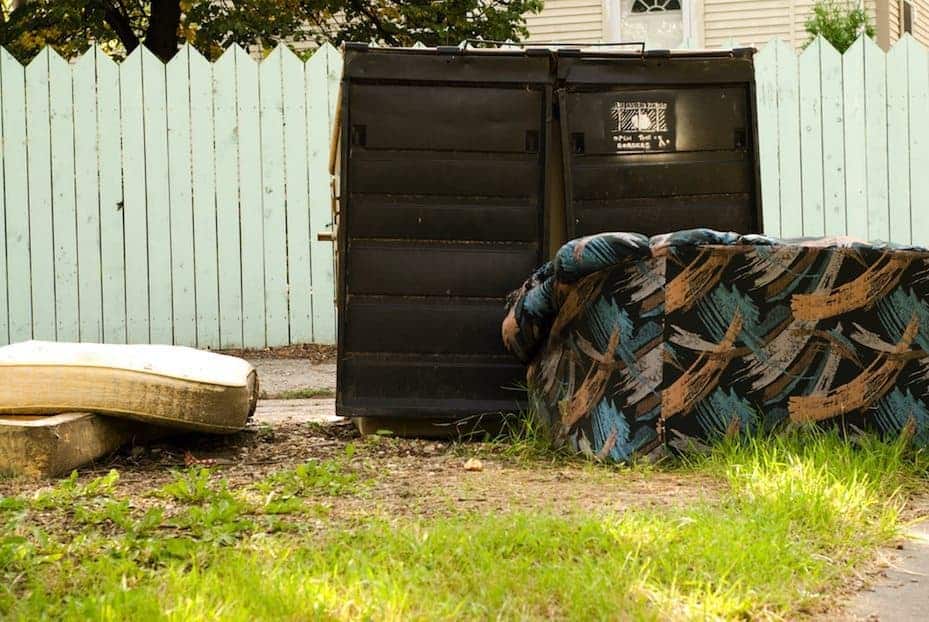
“Unscrupulous renovators build a business out of acquiring mattresses that are covered in stains and infested with bedbugs, sewing new covers on and then selling them to the unsuspecting consumer,” Brown says. “They take away as much as $1 billion in sales from legitimate manufacturers and retailers.”
ISPA’s long-term goal is to establish a national system for mattress recycling. With an estimated 50,000 mattresses discarded each day in the United States occupying as much as 23 cubic feet of landfill space apiece, an efficient recycling solution is needed, Trainer says. Communities across the nation are growing stricter about what can be disposed of in landfills, raising tipping fees or banning the practice of accepting mattresses entirely.
“All the resources contained in used mattresses are going to waste if they go to a landfill,” Trainer says. “ISPA is encouraging the development of a self-sustaining infrastructure for handling used bedding so that steel and other components can be efficiently extracted from mattresses and foundations and put to new uses. To do that, we need to develop new programs and increase participation in existing programs.”
Running a successful mattress recycling program isn’t easy. For starters, programs must establish an efficient way to collect and store mattresses. Then there’s the mattress disassembly process itself, which in North America still relies largely on hand labor to tear apart layers and separate and bale components. Finally, finding buyers for the components can be difficult, with raw material prices rising and falling with market demand. The cost of handling the old mattresses, tearing them down and preparing the recyclable materials for sale usually exceeds the value of the recycled materials, so most programs charge a processing fee just to break even.
To help cover expenses, most recycling centers currently charge a processing fee that can be $5 or more per piece.
When it comes to selling mattress and box-spring components, steel innersprings contain the most value, since there’s a steady market for scrap metal in most areas. Foam and fiber can be shredded and used in carpet padding and possibly insulation, and wood can be chipped for mulch or animal bedding or burned as biomass fuel. Finding a market for used cotton, shoddy and other textiles can be trickier. Mattress recycler Goodwill Industries of Duluth, Minn., is working with the Natural Resources Research Institute at the University of Minnesota to develop applications for its used cotton, perhaps as diesel and locomotive oil filters.
“It takes a great deal of time and effort to find destinations for all the key components,” says Greg Conkins, contributed goods manager for Goodwill Duluth, a nonprofit. He says that in the past fiscal year, the program shipped a total of more than 750,000 pounds of recycled bedding materials to its partners for use in making new products.
According to Brown, who spent much of his career as president of multistate retail chains Mattress Giant and Sleep Country USA, mattress recycling centers work best when they have a steady supply of product and an established market for component materials.
“Everything works more efficiently,” Brown says. “It makes it possible to automate some of the functions and drive down the cost. Larger recyclers also can take advantage of better commodity prices as they sell steel and foam.”
In order for economies of scale to be achieved, more segments of the industry need to get involved, Brown adds.
“We need the participation of all the major parties, from bedding manufacturers and retailers to hotels, schools and other institutions that handle large quantities of used bedding,” he says.
Recently, both the U.S. Navy and the Hilton hotel chain have announced mattress recycling campaigns. The Navy initiated a pilot program with Nine Lives Mattress Recycling in Pamplico, S.C., to break down 13,000 used mattresses from several ships. The program reportedly costs $12,000 less than simply having the discarded mattresses end up in a landfill and saves more than 100,000 cubic feet of landfill space.
Nine Lives charges a $5 recycling fee for each mattress and box spring it takes, and recycles up to 90% of mattress materials. The Navy says it hopes to expand the program to other naval ships, barracks and facilities.
On Nov. 1, Hilton Worldwide announced the launch of a mattress recycling program connected to the installation of new Serta mattresses and foundations at its properties. Working with DH Hospitality in Haymarket, Va., Hilton will recycle 85% of its hotels’ mattresses and box springs rather than diverting them to landfills. The components will be recycled into products such as tools, automobiles and construction materials (from reclaimed steel springs); tempered flooring, particleboard shelving and pressed wood products (from foundations); oil filters, mats and stuffing (from cotton fibers); and carpet padding (from foam quilt scrap).
DH Hospitality is installing and removing mattresses at Hilton’s properties, which have bought more than 50,000 mattresses in the past two years alone, the hotel chain says. DH will ensure that all components of the mattresses and box springs are being recycled, not resold or re-covered, by requiring partner recycling centers to provide a certificate of recycling. DH is a turnkey supplier of recycling, liquidation, transportation and warehousing nationwide.
“Programs like these send a strong message that recycling is the right thing to do,” Trainer says. “Hilton and other major businesses are recognizing the value of recycling in protecting the environment and connecting with consumers.”
A survey of 1,500 consumers by Spare Our Landfills in Phoenix found that 64% were strongly against mattresses being sent to landfills. In addition, 57% said they would support a recycling fee on the purchase of their next mattress and that $17.23 would be a reasonable fee. Nearly 80% said—all things being equal—they would select one retailer over another because it recycles.
“The idea of paying to dispose of something doesn’t translate into tangible value for many consumers, but that attitude seems to be changing,” Trainer says. “As interest in recycling grows, we as an industry need to offer more safe and efficient venues for disposing of mattresses in a way that meets consumers’ expectations.”
Goodwill program in Duluth hits its stride
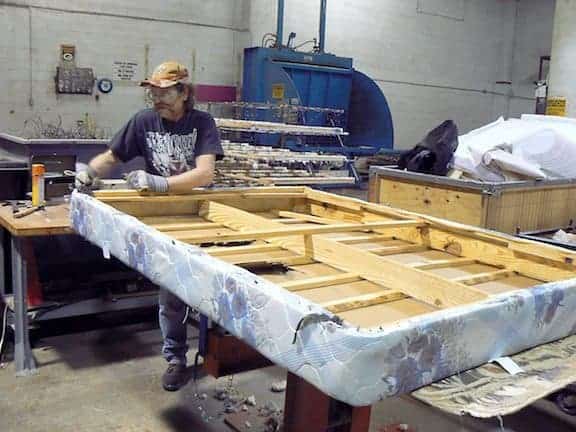
Breaking it down – Dennis Schleski dismantles a box spring at Goodwill Industries of Duluth, Minn. In fiscal 2012, the nonprofit recycled 88,200 pounds of wood from mattress foundations.
Goodwill Industries of Duluth, Minn., has deconstructed more than 120,000 mattresses and foundations since its mattress recycling program was launched in 2004. During the past two years, it has processed an average of 1,600 units a month—or 19,000 pieces per year—and those numbers keep going up, says Greg Conkins, contributed goods manager for the nonprofit.
Currently, about 72% of the bedding that Goodwill Duluth recycles comes from county solid waste collection programs. Furniture stores provide about 9% of the total; hotels are another important source. Goodwill Duluth doesn’t accept mattresses directly from the public. But it does have a partnership with 10 counties that provide 14 collection sites where consumers can drop off mattresses for recycling at a charge of $6 to $14.
Goodwill charges $7 per piece to the partnering counties, retail stores and hotels.
While Goodwill Duluth’s mattress recycling program is on solid ground today, with a steady flow of income from component sales, it has had its challenges. For example, at the height of the Great Recession in 2008, market demand for steel and other materials suddenly dried up and the organization was faced with a new set of cost pressures.
“There weren’t any scrap metal operations near Duluth that even wanted springs anymore,” Conkins says. “For a while, our only option was to ship our steel to a small recycler 70 miles away at our cost. We did this for a year until we found a solution.”
That solution came in the form of a new coil spring compactor developed by a local inventor. The compactor enables Goodwill Duluth to compress all its bulky steel bedsprings into tidy 90-pound cubes that meet the requirements of ME Global, a steel foundry located within five miles of Goodwill. The Natural Resources Research Institute, an offshoot of the University of Minnesota Duluth, assisted Goodwill Duluth in testing the steel for assurance that the foundry would be able to use the material in its manufacturing processes.
“The compactor provided us with an efficient way to compress this bulky material into a form that is much easier to store, transport and recycle,” Conkins says. “Once we had this, it opened up a major new market for us.”
In 2010, Goodwill Duluth sold 209 tons of steel to ME Global at an average price of $331 per ton, according to Conkins.
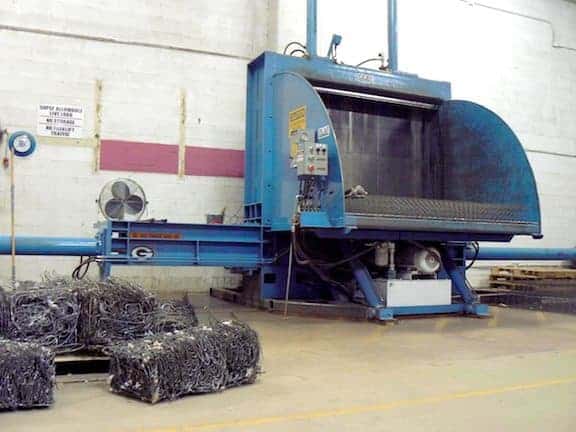
Squeezing steel – Goodwill Duluth’s custom-made mattress spring compactor, produced by Olaf Industries of Duluth, Minn., turns mattress springs into usable bales of steel.
Goodwill Duluth staffs its mattress recycling center with a team of five disabled individuals working 30 hours per week. Three workers handle the manual dismantling of mattresses. Another operates a hydraulically driven sheer machine that removes box springs from wood frames in a matter of seconds, as well as the spring compactor. A fifth worker bales fabrics and performs other duties.
“We have the capacity to double the number of pieces we handle each day now that we have the spring compactor,” Conkins says. He calculates that more than 90% of the components that Goodwill Duluth handles end up being recycled into new materials.
Goodwill Duluth expects to continue to expand its volume by developing new relationships with businesses and localities. It recently began working with a new county in Minnesota and it also is in talks with a group in southern Wisconsin “that may start sending mattresses our way,” Conkins says.
Conkins adds a number of other Goodwill locations throughout the country have expressed interest in duplicating the Duluth program—“and we hope to see more efforts like ours in the future.”
Blue Marble aims to be national recycler
A major new mattress recycling operation called Blue Marble Materials is set to officially open in the Los Angeles area on March 1. The enterprise is being launched by entrepreneur, Harvard Business School graduate and former Bain Capital professional Tchad Robinson of Clark Robinson Capital, a private equity firm based in Washington, D.C. Clark Robinson Capital’s other investments include a metal recycler in Colorado Springs, Colo., among other companies.
“We see an opportunity to provide a much-needed service,” Robinson says. “We will focus on disassembling the mattresses in the most efficient manner and then finding and developing new uses for the components. We intend to be the lowest-cost and highest-quality provider in each market that we enter.”
The first Blue Marble Materials recycling center will serve Los Angeles and San Diego counties and surrounding areas. A fleet of trucks will provide pickup for commercial customers. A fee will be charged on a sliding scale, based on the volume of mattresses provided.
After opening the Los Angeles site, Robinson plans to roll out an additional six mattress recycling centers in other major markets by the end of the first year and more than 40 sites after three years. Each center will be designed to handle 500,000 mattresses annually.
“We’re looking to obtain economies of scale in every area—from the recycling process to the marketing of raw components,” Robinson says. He expects Blue Marble to operate at break-even “for quite a while,” but sees it eventually becoming a profitable business “as we find new, creative uses for recycled foam, cotton, shoddy and other materials—and as the regulatory climate changes.”
Focused on both the business of recycling and the communities in which they operate, Blue Marble Materials centers will be run by a team of trained managers and staffed mostly by economically disadvantaged workers who live near the plants. The company will work closely with local governments to attract at-need groups looking for employment.
While Robinson plans to use machinery to gain efficiencies, the bulk of the work will remain manual because of challenges involved in tearing apart a typical mattress.
“It’s always going to be labor-intensive, but we’ll look for steps to automate where it makes sense,” he says.
Robinson’s long-range goal is to develop a national network of recycling centers serving major bedding retailers, hotels, educational institutions, the military and other groups that handle large quantities of used bedding in a variety of locations.
“Right now, their options are limited. If they’re lucky, there may be a small recycling center nearby connected to a ‘good Samaritan’ program like Goodwill. If not, they take all their used mattresses to the landfill or sell them to a renovator, who may or may not be legitimate,” Robinson says. “We offer a single-source solution that completely recycles these mattresses in a professional manner, protecting the environment and the public.”
Mattress maker creates its own system
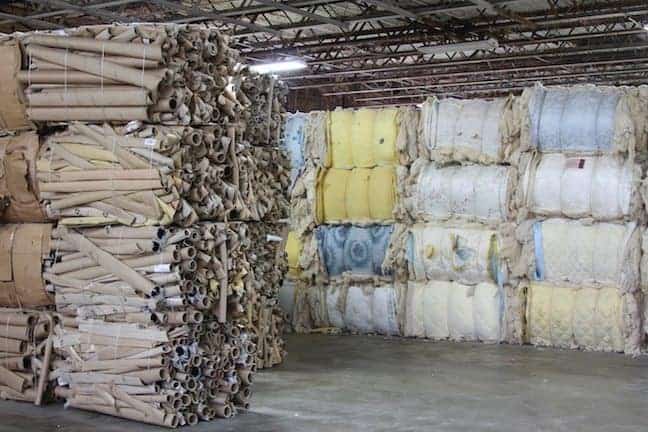
Taking beds back – Dream Green, operated by mattress maker Sleep Inc., provides recycling services at no charge to select retailers carrying Corsicana and Sleep Inc. products in Texas and neighboring states, as well as to hospitality customers.
Sleep Inc. provides recycling services at no charge to select retailers carrying Corsicana and Sleep Inc. products in Texas and neighboring states, as well as to hospitality customers. The company brings products to its facility on company trucks and operates at break-even by selling 97% of the materials it handles. Dream Green also accepts used bedding from its retail customers that is generated when dealers deliver new mattresses made by competitors of Corsciana and Sleep Inc.
“We are the only current bedding manufacturer that does its own mattress recycling,” says Doug Guffey, president of Sleep Inc. “Carroll Moran (Corsicana’s owner) has a passion for recycling and he took it upon himself to do whatever was needed to get our program going.”
A typical mattress takes up to 23 cubic feet of landfill space, according to Guffey. Multiply that by the thousands of mattresses that are tossed daily and the result is a huge amount of waste overloading the nation’s landfills.
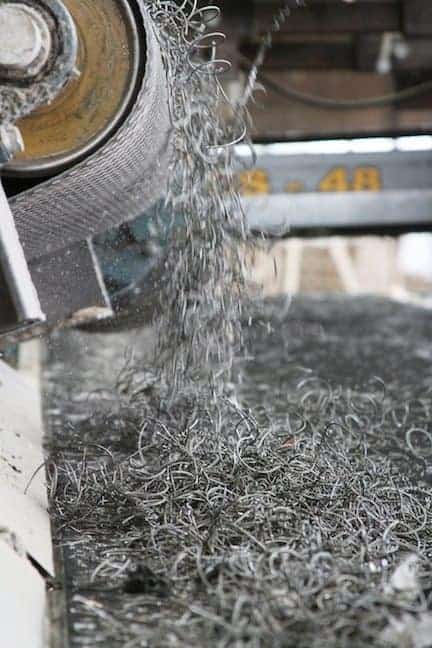
Mechanical help – Most of the work done to break down mattresses at Dream Green near Corsicana, Texas, is performed manually. But some equipment, including a steel grinder, is used.
“With Dream Green, we help the environment by taking used mattresses out of circulation so they aren’t dumped, and we also help the industry, since we’re taking these mattresses out of circulation so they won’t be resold,” he says.
Sleep Inc. staffs its facility with a team of 30 to 50 workers. Most of the labor is manual but the company also uses equipment where possible, including a steel grinder. The Dream Green site has the capacity to handle more volume, and Sleep Inc. is working hard to build awareness among its retailers and increase participation.
At the winter Las Vegas Market, the company debuted a 30-second video explaining the program.
“The video provides a quick look at why recycling is so important,” Guffey says. “We hope that it will encourage more retailers to come on board rather than selling their used bedding to renovators. Many retailers just don’t see the benefit of participating until you sit them down and really explain the impact.”
The video also is designed for in-store use to educate consumers, Guffey says.
Sleep Inc. intends to roll out additional Dream Green recycling facilities in other key markets it serves. It currently is looking at three possible locations and at least one new center will be open by the end of this year.
“The West Coast, with its strong environmental mindset, is a particularly good fit for our program,” Guffey says. He added that a location in the East also makes sense because of the population density and shortage of landfill space.
Prison system, nonprofit team up to recycle
Washington Correctional Industries, a division of the state’s Department of Corrections, recycled more than 100,000 mattresses and foundations in 2012. After processing, nearly 98% of the components contained in that bedding were used to create other products, rather than ending up in the landfill.
WCI launched its mattress recycling operation in 2009 with the assistance of Joe Paviglianti, former president and chief executive officer of retail chain Sleep Country USA and now a principal with Spare Our Landfills, a nonprofit organization committed to the proper disposal of used mattresses. The program initially began with Sleep Country, but expanded to include other area retailers and businesses, as well as municipalities throughout the state.
According to Paviglianti, the dumping of mattresses in Washington landfills has dropped more than 70% as a result of the WCI program.
“Before we started working with WCI, retailers had only two options: dump in the landfills or sell off to third parties with uncertain end results,” Paviglianti says. “With dumping fees rising and landfill rules becoming more restrictive, we recognized that it was time for a new approach. We set out to create a cost-effective, sustainable way to keep used bedding from ending up in landfills or being resold by unscrupulous retailers.”
The WCI program is a partnership with Spare Our Landfills, a consultancy based in Phoenix. Spare Our Landfills provides sales and marketing support to WCI, while WCI handles the workforce and transportation of recycled materials.
WCI operates three recycling centers—two in the western Washington and one on the eastern side of the state—staffed by as many as 50 low-level offenders. Workers disassemble mattresses by hand, then sort and bale the materials for shipment to other companies, where they are eventually repurposed into foam carpet padding, signs and other products. All metal components are separated manually and then sold for scrap to be melted and poured into new steel products.
While on the job, participating offenders have an opportunity to learn a variety of transferable skills, including operating a baler, driving a forklift and other basic warehousing functions. They also receive compensation for their work, which provides offenders the opportunity to pay off debts before their release.
“This program is a win-win,” Paviglianti says. “It helps protect the environment and provides valuable training and experience that enables these individuals to more successfully re-enter society.”
To help cover the program’s costs, WCI charges a fee for each mattress it recycles, based on volume. The average unit price is $7.25. WCI provides trailers for the collection of used mattresses, then picks up the trailers for delivery to its centers when they are full. Mattresses also can be dropped off directly at WCI centers.
Paviglianti sees the WCI program as a model that could work in other regions of the country, and he hopes that he may be able to announce at least one new program later this year.
“This program would be a good fit for certain states that have a culture of supporting correctional work enterprises,” he says.
College students create winning solution
A group of Belmont University business students and a Nashville nonprofit launched Spring Back Recycling in Nashville, Tenn., in March 2011 after winning seed money from the Values and Ventures competition at Texas Christian University. The new center began modestly with two part-time workers recycling about 80 mattresses per week from local businesses.
Today, just two years later, Spring Back Recycling has grown to a staff of five full-time workers, recycling 400 to 500 mattresses each week from businesses throughout Alabama, Arkansas, Kentucky and Tennessee.

Two-fold purpose – Organizers of Spring Back Recycling in Nashville, Tenn., say they have a dual goal: ‘building up lives while breaking down mattresses and protecting the environment.’
Through contracts with Allied-Republic Inc. and Waste Management Inc., the center recycles used bedding from health care, educational, government and hospitality institutions. It also works with local municipalities and a bedding retailer—Innovative Mattress Solutions in Winfield, W. Va.—and has even recycled mattresses from a Navy vessel in Virginia.
In October 2012, the Spring Back Recycling program was awarded the Enactus (formerly SIFE) World Cup, the highest honor in a prestigious competition involving the creation of socially responsible businesses by students throughout the world.
Developed in consultation with veteran bedding executive Barrie Brown and the International Sleep Products Association, Spring Back Recycling’s business model has two main goals, says John Gonas, the Belmont University finance professor who advises the program. One goal is to reduce the amount of waste entering local landfills by recapturing the value in used mattress components. The second and equally important goal: providing sustainable job opportunities to formerly incarcerated or homeless men.
“We’re building up lives while breaking down mattresses and protecting the environment,” Gonas says.
According to Gonas, the Spring Back program would never have gotten off the ground without the support of Belmont Church’s Isaiah 58 Ministries, a charitable outreach in Nashville that provides counseling and support to disenfranchised workers.
“They provide the team that staffs the center and they also manage the fixed and variable costs of the 8,000-square-foot facility,” Gonas says. “Social enterprises are hard to manage, but they were willing to take a risk and make our students’ idea a reality.”
Last summer, Spring Back Recycling licensed its business model to an entrepreneur in Denver, who has opened up Spring Back Colorado in partnership with a homeless shelter. Spring Back Recycling also has had a steady stream of inquiries from potential partners in other locations, including Chicago, Michigan, Wisconsin, Virginia and Tacoma, Wash.
“We’ve put countless hours into refining every aspect of this enterprise to make it as efficient and cost-effective as it can be,” Gonas says. “We now have a complete operations manual that provides a model that could be used in any major market where there are mounds of mattresses to dispose of and an opportunity for a nonprofit to invest in an earned-income revenue generator that is in line with their social mission.”
Like other recyclers, Spring Back breaks down mattresses into their raw materials such as cotton, metal, wood and foam. Each of these components is sold to scrap buyers for reuse. To help cover expenses, Spring Back also charges a sliding fee for each mattress it recycles, based on volume and condition. The center also handles mattress disposal for individual consumers, providing pickup service when needed.
More than 98% of everything that comes into Spring Back Nashville is recycled.
“So far, we’ve diverted more than 700,000 pounds of waste from landfills,” Gonas says.
Find a recycler
To find a mattress recycler in in the United States or Canada, check the International Sleep Products Association’s Bye Bye Mattress Recycling Locator.





